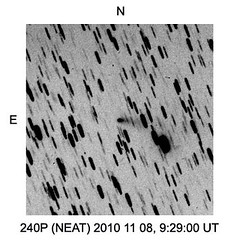(317) Roxane satellite named Olympia
The first numbered satellite of asteroid (317) Roxane was recently named Olympias by the Working Group on Small Body Nomenclature (WGSBN). This satellite was discovered in 2009 by team members: W. J. Merline, Southwest Research Institute (SwRI); P. M. Tamblyn, Binary Astronomy, Dillon, CO, U.S.A., and SwRI; J. D. Drummond, Starfire Optical Range, Air Force Research Laboratory; J. C. Christou, Gemini Observatory; A. R. Conrad, W. M. Keck Observatory; B. Carry, Observatoire de Paris; C. R. Chapman, SwRI; C. Dumas, European Southern Observatory (Chile); D. D. Durda, SwRI; W. M. Owen, Jet Propulsion Laboratory; and B. L. Enke, SwRI.
This image shows how asteroid (317) Roxane may look under sunlight on November 17, 2020, with the exception of its new satellite Olympia. Model 1049 is one of two models of (317) Roxane in the Database of Asteroid Models from Inversion Techniques (DAMIT).
The Database of Asteroid Models from Inversion Techniques (DAMIT) is a database of three-dimensional asteroid models that were derived using inversion techniques. The database and its web interface are operated by The Astronomical Institute of the Charles University in Prague, Czech Republic.
Creative Commons Attribution 4.0 International License. Link
(317) Roxane is a Main-belt Asteroid observable near 14th magnitude in the morning sky. Asteroid Roxane was discovered by A. Charlois, on September 11, 1891, at Nice, France.
References:
Circular 9099, (317) Roxane (December 2020)
MPEC 2020-V139: (317) Roxane I = Olympias (2020 November 14)
MPEC 2020-Q225: DAILY ORBIT UPDATE (2020 August 29)
Database of Asteroid Models from Inversion Techniques (DAMIT)
JPL Small Body Database browser
Minor Planet Center orbit and observation database
The first numbered satellite of asteroid (317) Roxane was recently named Olympias by the Working Group on Small Body Nomenclature (WGSBN). This satellite was discovered in 2009 by team members: W. J. Merline, Southwest Research Institute (SwRI); P. M. Tamblyn, Binary Astronomy, Dillon, CO, U.S.A., and SwRI; J. D. Drummond, Starfire Optical Range, Air Force Research Laboratory; J. C. Christou, Gemini Observatory; A. R. Conrad, W. M. Keck Observatory; B. Carry, Observatoire de Paris; C. R. Chapman, SwRI; C. Dumas, European Southern Observatory (Chile); D. D. Durda, SwRI; W. M. Owen, Jet Propulsion Laboratory; and B. L. Enke, SwRI.
This image shows how asteroid (317) Roxane may look under sunlight on November 17, 2020, with the exception of its new satellite Olympia. Model 1049 is one of two models of (317) Roxane in the Database of Asteroid Models from Inversion Techniques (DAMIT).
The Database of Asteroid Models from Inversion Techniques (DAMIT) is a database of three-dimensional asteroid models that were derived using inversion techniques. The database and its web interface are operated by The Astronomical Institute of the Charles University in Prague, Czech Republic.
Creative Commons Attribution 4.0 International License.
Link
(317) Roxane is a Main-belt Asteroid observable near 14th magnitude in the morning sky. Asteroid Roxane was discovered by A. Charlois, on September 11, 1891, at Nice, France.
References:
Circular 9099, (317) Roxane (December 2020)
MPEC 2020-V139: (317) Roxane I = Olympias (2020 November 14)
MPEC 2020-Q225: DAILY ORBIT UPDATE (2020 August 29)
Database of Asteroid Models from Inversion Techniques (DAMIT)
JPL Small Body Database browser
Minor Planet Center orbit and observation database















